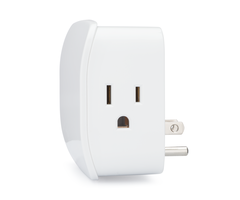Using Andersen Door and Window Sensors w/ the 345 MHz Qolsys IQ Panel 2 Plus
Posted By Michael GorisIf you are looking for a wireless sensor solution that comes fully integrated into a door or window, then Andersen Doors and Windows might be for you. There are many Andersen Doors and Windows that come with integrated 345 MHz wireless sensors for using with a compatible alarm system.

The wireless sensors that come built into Andersen Doors and Windows are commonly referred to as Andersen Verilock Sensors. For a complete list of Andersen Doors and Windows that utilize these integrated sensors, please see this FAQ as a reference. While we are specifically using this post to highlight the compatibility between the Andersen Verilock Sensors and the 345 MHz Qolsys IQ Panel 2 Plus, there is no reason why you couldn't also use these sensors with a different 345 MHz system, like the Honeywell Lyric or one of the Honeywell LYNX Touch Panels.
The 345 MHz Qolsys IQ Panel 2 Plus serves as a great system for the integrated Andersen Door and Window Sensors, specifically due to the fact that the IQ2+ supports a large number of wireless zones (up to 128). This is important because each Andersen Verilock Sensor will typically use two (2) wireless zones for full system operation. One zone (Loop 1) will monitor for the door or window being opened/closed. The other zone (Loop 2) will monitor for the door or window being locked/unlocked. These sensors have a wireless range of roughly 500 feet when used in an open air environment. Remember that obstacles like thick walls and large metal objects can reduce wireless range.
One very important thing to note about Andersen products is that they are typically only sold through licensed Andersen dealers. Alarm Grid cannot sell these sensors directly. Also, Andersen mandates in its terms of service that their integrated door and window sensors only be installed by professional installers who are certified and approved by Andersen. Failure to comply with the Andersen terms of service can result in the warranty for your door or window being terminated. It is strongly advised that you visit the Andersen website and contact a dealer in your area if you are serious about installing these doors and/or windows.
While Andersen does have strict policies regarding the sale and installation of their integrated sensors, they also have an extensive YouTube Channel with lots of informational and how-to videos involving their products. It is truly a great resource for everyone from the DIY weekend warrior looking to complete their own installation, to the professional installer certified by Andersen. We posted a general informational video from Andersen above, but there are plenty more to check out if you are hoping to learn more about these products.
The best complement for Andersen Security Doors and Windows is alarm monitoring service. And that is a job for Alarm Grid! We offer monitoring plans for all needs and budgets so that you can have an automatic response if your Andersen Door or Window detects activity. If you are hoping to get started with Alarm Grid monitoring service, feel free to email us at support@alarmgrid.com. Our technicians and security planners will be happy to help you get started with monitoring service for your home or business. We check our email from 9am to 8pm ET M-F. We look forward to hearing from you soon!














 If you aren't familiar with the FF345, it is a
If you aren't familiar with the FF345, it is a